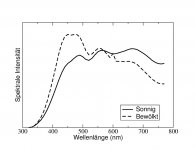Holger (post 53),
I can not help a non-believer, but I trust our measurements, since we know very well what we are doing, we are aware of potential pittfalls and we checked the measurements over and over. In addition we had our spectrometer calibrated by measuring standard instruments which were also measured by a German calibration institute and we had within experimental error exactly the same results. The only deviations which we could have are in the wavelenght range 450-460 nm, but that has to do with the relatively low output of blue light of our source of white light: a stabilised tungsten light source. That problem can be tackeled by collecting enough counts in the channels of the photon counter designated to these wavelengths since the uncertainty is connected to the square root of he total amount of counts collected in these channels. Over and we found the same results as Swarovski with their spectrometer (see their data sheet in which a transmission of 96% is reported for the Habicht 8x30).
We have also compared or data from different binoculars with data obtained by Zeiss with their spectrometer and we had the same results.
Zeiss found a (green) light transmission for the HT's of 95,3%, we measured 95,1-95,2%, which is within experimental error the same.
So I am not trying to convert you from a non-believer to a believer, but scientific pride does not permit us to make stupid mistakes and we are fully independent from whatever company, what does sometimes not make us popular.
Gijs






